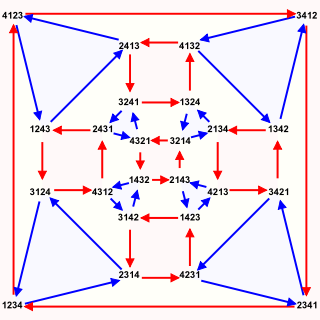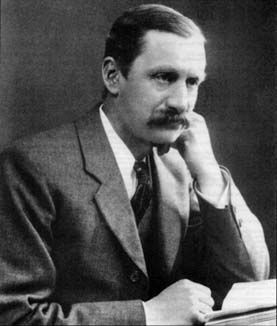
In mathematics, specifically group theory, given a prime number p, a p-group is a group in which the order of every element is a power of p. That is, for each element g of a p-group G, there exists a nonnegative integer n such that the product of pn copies of g, and not fewer, is equal to the identity element. The orders of different elements may be different powers of p.

In abstract algebra, the symmetric group defined over any set is the group whose elements are all the bijections from the set to itself, and whose group operation is the composition of functions. In particular, the finite symmetric group defined over a finite set of symbols consists of the permutations that can be performed on the symbols. Since there are such permutation operations, the order of the symmetric group is .

In mathematics, specifically in group theory, the concept of a semidirect product is a generalization of a direct product. There are two closely related concepts of semidirect product:

In mathematics, specifically in the field of finite group theory, the Sylow theorems are a collection of theorems named after the Norwegian mathematician Peter Ludwig Sylow that give detailed information about the number of subgroups of fixed order that a given finite group contains. The Sylow theorems form a fundamental part of finite group theory and have very important applications in the classification of finite simple groups.

In mathematics, more specifically in the field of group theory, a solvable group or soluble group is a group that can be constructed from abelian groups using extensions. Equivalently, a solvable group is a group whose derived series terminates in the trivial subgroup.
In mathematics, specifically group theory, the index of a subgroup H in a group G is the number of left cosets of H in G, or equivalently, the number of right cosets of H in G. The index is denoted or or . Because G is the disjoint union of the left cosets and because each left coset has the same size as H, the index is related to the orders of the two groups by the formula

A group is a set together with an associative operation that admits an identity element and such that there exists an inverse for every element.
In mathematics, more specifically in group theory, the character of a group representation is a function on the group that associates to each group element the trace of the corresponding matrix. The character carries the essential information about the representation in a more condensed form. Georg Frobenius initially developed representation theory of finite groups entirely based on the characters, and without any explicit matrix realization of representations themselves. This is possible because a complex representation of a finite group is determined by its character. The situation with representations over a field of positive characteristic, so-called "modular representations", is more delicate, but Richard Brauer developed a powerful theory of characters in this case as well. Many deep theorems on the structure of finite groups use characters of modular representations.
In mathematics, the Feit–Thompson theorem, or odd order theorem, states that every finite group of odd order is solvable. It was proved by Walter Feit and John Griggs Thompson.

In mathematics, specifically group theory, a Hall subgroup of a finite group G is a subgroup whose order is coprime to its index. They were introduced by the group theorist Philip Hall (1928).

In mathematics, Burnside's theorem in group theory states that if G is a finite group of order where p and q are prime numbers, and a and b are non-negative integers, then G is solvable. Hence each non-Abelian finite simple group has order divisible by at least three distinct primes.
The Schur–Zassenhaus theorem is a theorem in group theory which states that if is a finite group, and is a normal subgroup whose order is coprime to the order of the quotient group , then is a semidirect product of and . An alternative statement of the theorem is that any normal Hall subgroup of a finite group has a complement in . Moreover if either or is solvable then the Schur–Zassenhaus theorem also states that all complements of in are conjugate. The assumption that either or is solvable can be dropped as it is always satisfied, but all known proofs of this require the use of the much harder Feit–Thompson theorem.
In mathematics, especially in the area of algebra known as group theory, a complement of a subgroup H in a group G is a subgroup K of G such that
In mathematics, especially in the area of algebra known as group theory, the term Z-group refers to a number of distinct types of groups:
In mathematical group theory, a normal p-complement of a finite group for a prime p is a normal subgroup of order coprime to p and index a power of p. In other words the group is a semidirect product of the normal p-complement and any Sylow p-subgroup. A group is called p-nilpotent if it has a normal p-complement.
In abstract algebra, the focal subgroup theorem describes the fusion of elements in a Sylow subgroup of a finite group. The focal subgroup theorem was introduced in and is the "first major application of the transfer" according to. The focal subgroup theorem relates the ideas of transfer and fusion such as described in. Various applications of these ideas include local criteria for p-nilpotence and various non-simplicity criteria focussing on showing that a finite group has a normal subgroup of index p.
In the area of modern algebra known as group theory, the Suzuki groups, denoted by Sz(22n+1), 2B2(22n+1), Suz(22n+1), or G(22n+1), form an infinite family of groups of Lie type found by Suzuki (1960), that are simple for n ≥ 1. These simple groups are the only finite non-abelian ones with orders not divisible by 3.
In mathematical representation theory, coherence is a property of sets of characters that allows one to extend an isometry from the degree-zero subspace of a space of characters to the whole space. The general notion of coherence was developed by Feit, as a generalization of the proof by Frobenius of the existence of a Frobenius kernel of a Frobenius group and of the work of Brauer and Suzuki on exceptional characters. Feit & Thompson developed coherence further in the proof of the Feit–Thompson theorem that all groups of odd order are solvable.








